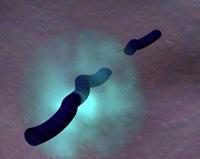Bacteria that synthesizes new protein
Two groups of researchers have made a bacterium form proteins with amino acids not present in other organisms, according to the journal Science. Thanks to these works, new pathways in molecular biology are opened, as researchers can develop medicines and other proteins made with the new amino acid.
In their article "Playing with the components of the structure of life" (04/04/2001), by Zientzia.net, it was explained that they developed a method of introducing new or unnatural amino acids into proteins. But so far they did not get this work done by living organisms.

In living beings, thanks to proteins (aminoazil-tRNA synthetase) amino acids bind with their transfer RNA. The California team of researchers, led by Peter Schultz, has genetically modified this synthetase to associate an unnatural amino acid (O-methyl-L-tyrosine) with the transfer RNA. The transfer RNA has also been genetically modified to be able to know the genetic code introduced in a gene. This code forces the mechanism of E. coli bacteria to introduce the unnatural amino acid into the protein. Success has reached almost 100%.
The group led by French biochemist Paul Schimmel has addressed the issue from another point of view. Nearly half of these syntherates have a corrective function to ensure that they bind the appropriate amino acid to the transfer RNA. If by doing the correction they find some error, they release a wrong amino acid. This way, the transfer RNA may have another option. Therefore, the Schimmel group has transformed the part that has the correction function of this synthetase. This change allows the synthetase to associate the unnatural amino acid with the transfer RNA, becoming part of the protein.
These two steps are very important and give way to new research.
Buletina
Bidali zure helbide elektronikoa eta jaso asteroko buletina zure sarrera-ontzian











